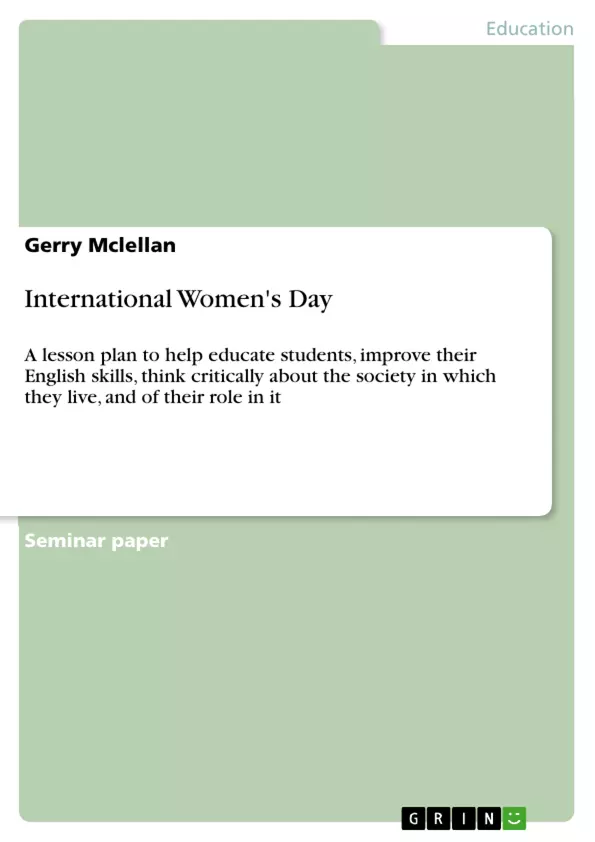This paper attempts to show how lesson plans should be created to take into account the needs of individual students or classes, help with a particular EFL or EAP sub-skill, raise cultural awareness in students and have them think critically about issues that are pertinent to them and to society at large. The author believes that lessons should not be or be seen to be isolated from the outside world. Instead, students should be able to instantly use their newfound knowledge to interact with others outside of the classroom. In any subject, be it science, maths or history, there has to be a connection between what students are learning and the reasoning behind it. Although this idea of Content and language Integrated Learning (CLIL) has been around since Confucius’ times, many educators assume the connection between the lesson taught and society at large is implicit. This essay attempts to rationalize reasons for the content of one particular lesson and show how it is expected to raise student awareness of the role of women in society. Upon completion of the lesson, students will answer a survey and the author will use the feedback as the focus of a subsequent paper.
Inhaltsverzeichnis (Table of Contents)
- Abstract
- Introduction
- Background to my personal teaching and assessment beliefs
- Rationale for the lesson topic matter
- Research Questions and Lesson Procedure
Zielsetzung und Themenschwerpunkte (Objectives and Key Themes)
This paper aims to demonstrate how lesson plans should be designed to cater to individual student needs, improve English language skills, enhance cultural awareness, and encourage critical thinking about societal issues. The author emphasizes the importance of connecting classroom learning with real-world applications, promoting a seamless transition from academic knowledge to practical interaction.
- Creating effective lesson plans that address individual student needs
- Developing English language skills through a specific lesson topic
- Fostering cultural awareness and critical thinking among students
- Bridging the gap between classroom learning and real-world applications
- Analyzing student feedback to inform future lesson development
Zusammenfassung der Kapitel (Chapter Summaries)
- Abstract: This section provides a brief overview of the paper's purpose, highlighting the focus on developing a lesson plan that addresses individual student needs, enhances language skills, and promotes critical thinking about societal issues. The author emphasizes the importance of connecting classroom learning to real-world applications.
- Introduction: The introduction discusses the author's belief that lessons should be designed to connect classroom instruction with the world outside. The paper focuses on a specific lesson designed to inform students about a relevant issue, enhance language skills, and promote critical thinking. The author aims to share the rationale behind the lesson design and its expected outcomes, emphasizing the importance of student feedback in informing future lesson development.
- Background to my personal teaching and assessment beliefs: This section explores the author's personal beliefs about education policy and the importance of fostering student engagement. The author critiques the current emphasis on standardized testing and argues for a more holistic approach to education that encourages critical thinking and a deeper understanding of the world around us.
- Rationale for the lesson topic matter: This section explains the author's inspiration for developing a lesson focusing on the role of women in society. The author's goal is to evoke student feedback and involve them in a discussion about a relevant issue that affects them and future generations. The author also emphasizes the importance of creating engaging and culturally relevant learning experiences for students.
- Research Questions and Lesson Procedure: This section details the research questions guiding the paper and outlines the lesson plan structure. The author explores the effectiveness of Content and Language Integrated Learning (CLIL) instruction, particularly in relation to gender-specific topics. The section also provides insights into the author's approach to lesson planning and implementation, emphasizing flexibility and student-centered learning.
Schlüsselwörter (Keywords)
Key terms and concepts explored in this paper include: Content and Language Integrated Learning (CLIL), lesson plan design, cultural awareness, critical thinking, student engagement, feedback analysis, teaching methodology, and the role of women in society.
- Quote paper
- Gerry Mclellan (Author), 2018, International Women's Day, Munich, GRIN Verlag, https://www.grin.com/document/441755



